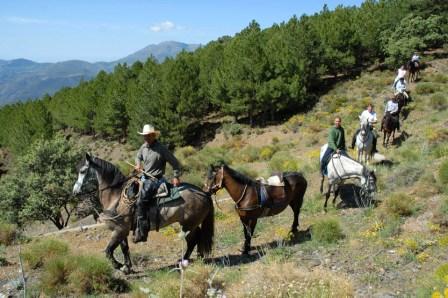If you are spending some time in Granada then once you have spent a few days doing the main attractions and the Alhambra in the centre then it is time to hire a car and explore the beautiful surrounding region.
 Granada is surrounded by the snow capped peaks of the Sierra Nevada mountains and there are a number of excursions to be made from here. From the top of the highest mountain peak you can see the coast of Africa, and on the clearest days you have a view of Castilla la Mancha in the central part of eastern Spain. The Sierra Nevada is the home of the Spanish ibex and if you like trekking it is the most rewarding territory in Andalusia.
Granada is surrounded by the snow capped peaks of the Sierra Nevada mountains and there are a number of excursions to be made from here. From the top of the highest mountain peak you can see the coast of Africa, and on the clearest days you have a view of Castilla la Mancha in the central part of eastern Spain. The Sierra Nevada is the home of the Spanish ibex and if you like trekking it is the most rewarding territory in Andalusia.
It us well worth hiring a car and taking day trips from Granada to explore and below are a few suggestions of local attractions:
1. If you are a fan of Federico García Lorca head 17km northwest of Granada to Fuente Vaqueros where you will find the Casa-Museo Federico García Lorca where the poet-playwright was born in 1898. He lived in this village until age 6 and there are a number of photos of the artist, posters and costumes from his plays.
2. The village of Viznar which is 9km northeast of Granada (head out the N-342 and follow the signs for the turn off to Viznar) was where the fascists brought Lorca to be beaten and shot in 1936 when they took over Granada.
3km outside the village on the road to Alfacar is the Federico García Lorca Memorial Park where a marker pinpoints the spot where the poet was assassinated. Lorca's body was never recovered, so there is no grave for pilgrims to seek out.
3. Guadix is 67km from Granada and will take about 45 minutes to drive. It is famous because almost half of the inhabitants live underground in the southern part of the town in cave houses in "Barrio Troglodyte". Andalucians have been fond of living underground since Moorish times because it is the best way of escaping the summer heat, and a number of the cave-dwellings are well-appointed, and some are even quite luxurious, with marble floors, fitted kitchens, faxes and internet connections.
In the centre of Guadix there is a Cathedral which was founded in 1594, and the Cave Museum - Plaza de la Ermita Nueva S/n.
Purullena is a nearby village with a disco inside a cave, and you can also buy the local handcrafted earthenware here which is sold on the roadside.
If you leave Guadix on the N324 in the direction of Almeria you will come across the village of La Calahorra where there is a fascinating Castle just a few miles to the East. It was awarded to a Christian knight for his role in the Reconquest, and he installed a fabulous Renaissance courtyard made of Italian marble made by Florentine craftsmen.
4. Las Alpujarras which is one of the most remote and fascinating parts of Andalusia. It is 145 km from Granada and will take you about 2 hours to drive. La Alpujarra is a spectacularly beautiful region on the southern flanks of the Sierra Nevada mountains, with deep, sheltered valleys and gorges and plains dotted with more than 50 picturesque villages which are so impenetrable that the Moors managed to hold out there for over a century after the fall of Granada in 1492. It falls within the Sierra Nevada National Park and is an important hiking destination.
The Alpujarra is famous because of its unique mini-ecology with terraced farmlands constantly watered by the melting snow from above, forming a high-altitude oasis of greenery which stands in dramatic contrast to the dry foothills below. The average altitude is 4,000 feet above sea level. Perhaps the most picturesque villages are three which cling to the slopes of the Poqueira Valley, where red peppers and tomatoes are set out to dry on the flat clay roofs. Pampaneira is at the bottom and full of craft shops and restaurants. Bubion is half way up the slope with a huge square church tower standing on a plaza of rough paving stones. But the most authentic Alpujarra, is Capileira at the top of the valley (its name is an Arabic derivation of the Latin word for head or top). You can walk down from the road into the lower streets of the village, where the rocky streets, overhanging passageways and sagging, stone houses have still not been modified for contemporary living.
While you are driving around this area look out for the herds of mountain goats and the colourful Hoopoe bird with its haunting cry is also a common sight.
The capital of the region is Orgiva on the lowlands, and the village of Trevelez is famous throughout Spain for its superb mountain hams (jamón Serrano) situated at over 4,840 feet above sea level and the highest village in Europe, overhanging a fast-flowing river and plunging mountain valley.